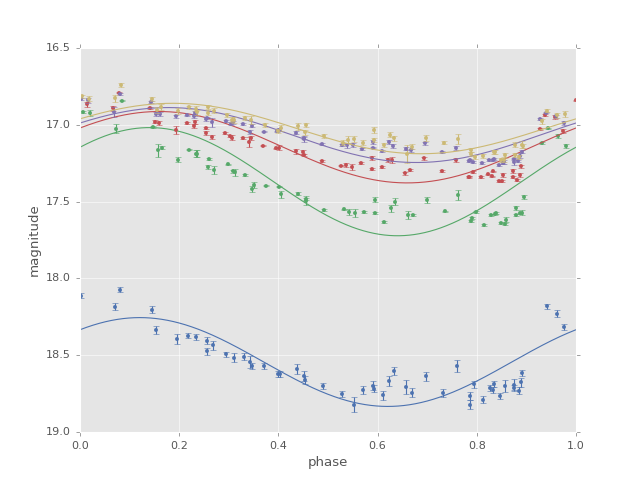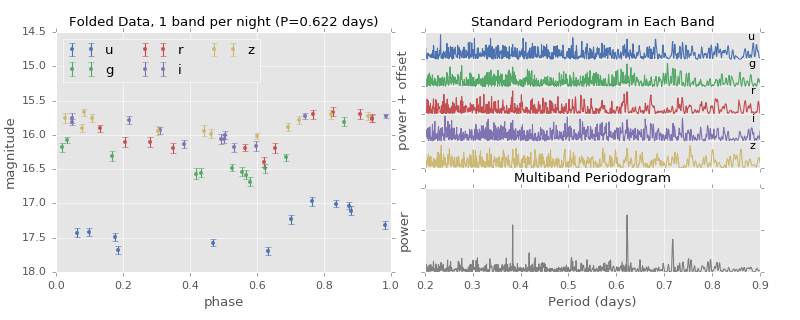Multiband Lomb-Scargle Periodogram¶
Though classical periodogram approaches only handle a single band of data,
multiband extensions have been recently proposed. gatspy implements one
which was suggested by
VanderPlas et al.
The interface is almost identical to that discussed in
Lomb-Scargle Periodogram, with the exception of the fit() method and
predict() method requiring a specification of the filters.
Two versions of the multiband periodogram are available:
LombScargleMultiband- This class implements the flexible multiband model described in VanderPlas (2015). In particular, it uses regularization to push common variation into a base model, which effectively simplifies the overall model and leads to less background signal in the periodogram.
LombScargleMultibandFast- This class is a faster version of the multiband periodogram without
regularization. This means that it cannot fit the same range of models as
LombScargleMultiband, but essentially just combines several independent band-by-band fits.
Here is a quick example of finding the best period in multiband data. We’ll
use LombScargleMultibandFast here.
We start by loading the lightcurve (for more information, see Datasets (gatspy.datasets)):
In [1]: from gatspy import datasets, periodic
In [2]: rrlyrae = datasets.fetch_rrlyrae()
In [3]: lcid = rrlyrae.ids[0]
In [4]: t, mag, dmag, filts = rrlyrae.get_lightcurve(lcid)
With this lightcurve specified, we can now build and fit the model:
In [5]: model = periodic.LombScargleMultibandFast(fit_period=True)
In [6]: model.optimizer.period_range=(0.5, 0.7)
In [7]: model.fit(t, mag, dmag, filts);
And, as with the single-band version, the best period is now stored as an attribute of the model:
In [8]: model.best_period
Out[8]: 0.61431670719850195
Once the model is fit, we can then use the predict() method to
look at the model prediction for any given band:
In [9]: tfit = np.linspace(0, model.best_period, 1000)
In [10]: magfit = model.predict(tfit, filts='g')
In [11]: magfit[:4]
Out[11]: array([ 17.1411512 , 17.13947457, 17.13780707, 17.13614876])
Below is a plot of the magnitudes at this best-fit period:
(Source code, png, hires.png, pdf)

We see that the simplest multiband model is just a set of offset sine fits to the individual bands. As in the single-band case, the model is not a particularly good fit to the data, but nevertheless it is useful in determining the period from the data.
A more sophisticated multiband approach involves model simplification via a
regularization term that pushes common variation into a “base model”; this
is slightly slower to compute, but can be accomplished with the
LombScargleMultiband model. For example, here is a comparison of the
single-band periodograms to this regularized multiband model on six months
of sparsely-sampled LSST-style data:
(Source code, png, hires.png, pdf)

Notice in this figure that periodograms built from individual bands fail to locate the frequency, while the periodogram built from the entire dataset has a strong spike in power at the correct frequency.
For more information on these multiband methods, see the VanderPlas et al. paper, and the associated figure code at http://github.com/jakevdp/multiband_LS/